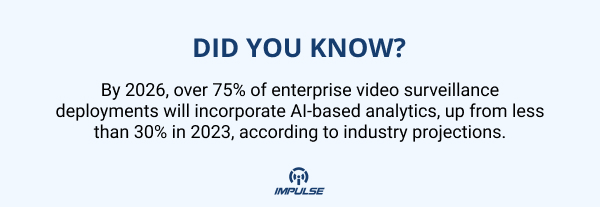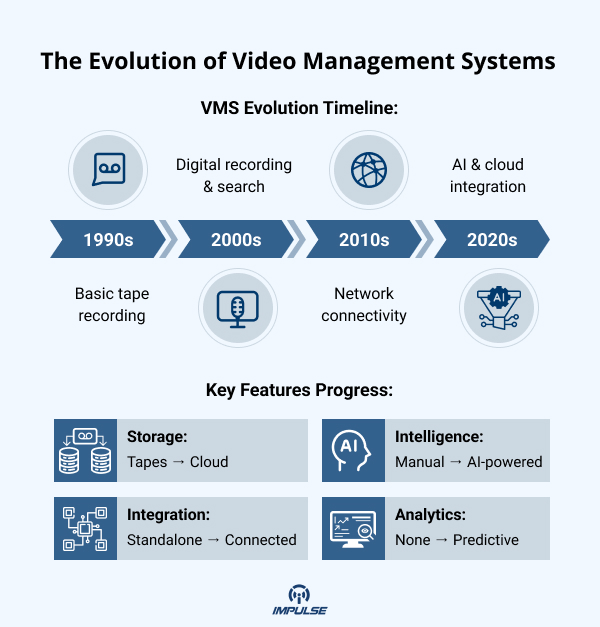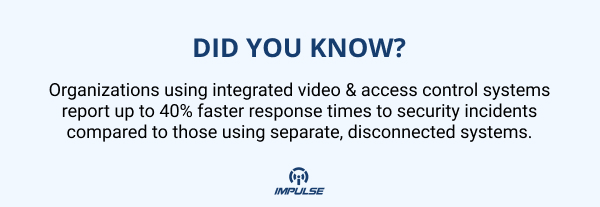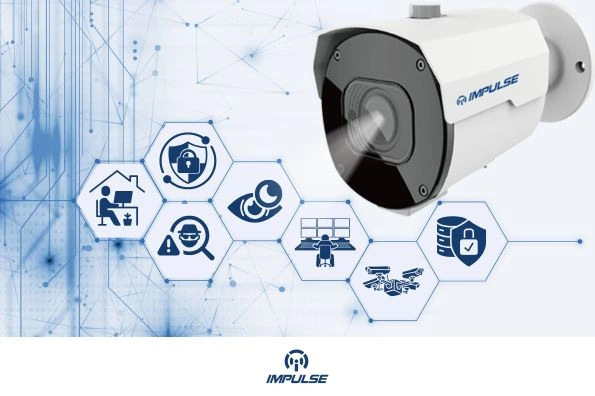Organizations today face an unprecedented challenge: managing and extracting value from massive amounts of video data. Security operations that once monitored a handful of cameras now oversee hundreds or thousands of video feeds simultaneously. Healthcare facilities struggle to integrate patient monitoring with broader security systems. Manufacturing plants can’t effectively analyze production line footage for quality control. Retail chains lack the tools to transform surveillance from a passive security measure into actionable business intelligence.
Traditional video management approaches simply cannot scale to meet these demands. Storage costs spiral out of control. Security teams drown in footage they can’t effectively monitor. Critical incidents are missed. Valuable data patterns remain hidden, locked away in inaccessible video formats across disconnected systems.
The consequences are serious: security vulnerabilities, compliance failures, missed business opportunities, and significant resource waste. The fundamental problem isn’t just about having more cameras—it’s about the growing gap between video collection capabilities and video management effectiveness.
Rethinking Video Management for Modern Challenges
The solution to this crisis lies in reimagining what video management systems (VMS) can do. Today’s advanced VMS platforms are transforming from simple recording and playback tools into comprehensive enterprise solutions that integrate with business operations, leverage AI capabilities, and create actionable intelligence from video data.
The latest generation of VMS technology addresses these challenges through four key capabilities:
- Intelligent Processing: Using AI to transform raw footage into structured data
- Seamless Integration: Connecting video systems with other business tools and platforms
- Scalable Architecture: Handling growing camera networks without proportional cost increases
- Actionable Analytics: Converting video from a passive resource into a source of business intelligence
These capabilities aren’t just incremental improvements they represent a fundamental shift in how organizations can extract value from their video assets.

Key Trends Shaping the Future of Video Management
Cloud-Native VMS Solutions
Cloud-based and hybrid-cloud video management represents a major architectural shift in the industry. Modern VMS platforms now offer cloud-native options that dramatically reduce on-premise hardware requirements, provide dynamic resource allocation during peak periods, and enable automatic scaling as camera networks grow. These platforms also offer simplified remote access for authorized personnel while maintaining built-in redundancy and disaster recovery capabilities. This cloud transformation is especially beneficial for multi-site operations, enabling centralized management while preserving appropriate local control and access.
AI-Powered Video Analytics
Artificial intelligence has revolutionized video data management capabilities. Advanced VMS solutions now incorporate sophisticated features like object recognition for identifying specific items, vehicles, and behaviors, along with automated detection of unusual activities and security exceptions. The technology also enables facial recognition with appropriate privacy controls, traffic pattern and crowd movement analysis, heat mapping for retail customer behavior, and manufacturing quality control through visual inspection. These capabilities transform passive monitoring into proactive management, allowing systems to alert operators to specific conditions rather than requiring constant human vigilance.

Edge Computing and Distributed Architecture
The newest VMS architectures leverage edge computing to process video data closer to its source. This approach provides numerous benefits including reduced bandwidth requirements for video transmission, lower latency for time-sensitive applications, improved processing efficiency through distributed workloads, enhanced privacy by processing sensitive data locally, and greater system resilience without single points of failure. These distributed approaches are particularly valuable for installations with bandwidth constraints or latency-sensitive applications like access control integration.
Open Platform Integration
Modern VMS systems have moved away from closed ecosystems, now embracing open standards and APIs for greater flexibility and integration. This open architecture enables seamless connection with access control and alarm systems, building management platforms, and business intelligence tools. The systems can support cameras from multiple manufacturers and allow for custom application development to meet specific business needs. Through this openness, video management has evolved from a standalone security function into an integrated business system that can exchange data bidirectionally with other enterprise platforms, creating a more cohesive and efficient operational environment.

Innovations Transforming Video Management
Behavioral Analytics and Predictive Security
The most advanced VMS platforms now incorporate sophisticated predictive capabilities that enhance security operations. These systems can identify patterns indicating potential security risks before incidents occur, detect behaviors that deviate from established norms, and track objects seamlessly across multiple camera views to maintain comprehensive situational awareness. Furthermore, they can automatically trigger response workflows when specific conditions are detected and continuously learn from historical data to improve their detection accuracy over time. Through these advanced features, security operations are transformed from a reactive approach focused on documenting incidents after they occur to a proactive strategy capable of preventing security breaches before they happen.
IoT Sensor Integration
Modern video management systems have evolved beyond standalone solutions to become highly integrated platforms. They now seamlessly connect with a diverse range of sensors and monitoring tools, including environmental sensors that track temperature, humidity, and air quality; occupancy and motion detectors; sophisticated audio analytics with gunshot detection capabilities; RFID and Bluetooth tracking systems; and industrial equipment performance monitors. This comprehensive integration of multiple data sources creates a powerful sensor fusion that enhances the value and actionability of video data, providing organizations with a complete operational overview that goes far beyond traditional camera-only surveillance.
Smart Visual Search Capabilities
Finding specific content in vast video archives has traditionally been a major challenge. However, new search technologies have revolutionized how we access and analyze video footage. Modern systems now support sophisticated natural language queries, allowing users to make requests like “Show me all red trucks at the loading dock.” They also enable similarity-based searches where users can find similar events across their video archive, along with powerful attribute filtering capabilities. Advanced features include cross-camera event tracking and temporal pattern detection across extended timeframes. These sophisticated search and analysis capabilities have transformed video management, making it possible to quickly locate and utilize relevant footage from even the largest video archives. What was once an overwhelming amount of data has become an accessible and valuable resource for organizations.
Advanced Compression and Storage Optimization
Managing the sheer volume of video data remains a critical challenge. Modern video management systems have introduced several innovative solutions to address this, including AI-driven variable compression that adjusts based on content importance, intelligent retention policies that ensure critical footage is preserved longer, and automated summarization capabilities for extended video periods. Additionally, these systems employ motion-based selective recording to reduce storage requirements and format optimization tailored for specific review and analysis needs. These sophisticated technologies enable organizations to retain more useful video within the same storage footprint, significantly improving both cost-effectiveness and data availability.
Zero-Trust Security Frameworks
As video systems become increasingly connected, security concerns grow proportionally. Modern VMS platforms incorporate robust security features to address these challenges. They implement granular permission controls that restrict access down to specific camera views, require multi-factor authentication for sensitive operations, and maintain comprehensive audit trails of all system access and use. Additionally, these platforms ensure data security through encrypted storage and transmission of video data, while also providing automated compliance reporting to meet regulatory requirements. Through these sophisticated security measures, organizations can confidently expand their video management capabilities without compromising on security or privacy.
The Future-Proof VMS: IMPULSE XTRA
Among the solutions leading this transformation is the IMPULSE XTRA Video Management System, an enterprise-grade platform developed in Canada with user experience as the top priority. This system exemplifies many of the innovations reshaping the industry:
- Resource Efficiency: Supporting four times more cameras on the same server hardware compared to legacy systems
- User-Centric Design: Intuitive interfaces that reduce training requirements and improve operator effectiveness
- Enterprise Reliability: Designed for mission-critical operations with redundancy and failover capabilities
- Intelligent Modules: Incorporating AI-powered analytics for specific business applications
- Architectural Flexibility: Supporting on-premise, cloud, and hybrid deployments
- Mobile-First Approach: Full-featured mobile clients providing access from anywhere
By embracing these innovations, IMPULSE XTRA demonstrates how modern VMS platforms can solve the fundamental challenges organizations face in managing growing video resources.
Implementing Next-Generation Video Management
Organizations looking to leverage these advances should approach VMS implementation strategically:
- Begin with clear business objectives rather than technical specifications
- Evaluate both immediate needs and future scalability requirements
- Consider total cost of ownership, not just acquisition expenses
- Prioritize open platforms that can evolve with changing needs
- Implement in phases with measurable success criteria
The most successful deployments treat video management not as an isolated security function but as a strategic business system that provides value across multiple departments and operations.
Conclusion
The future of video management isn’t just about better cameras or more storage it’s about transforming video from a passive recording medium into an active source of business intelligence. The systems that will deliver the greatest value are those that can bridge the gap between collecting video and creating actionable insights from it.
Organizations that embrace these advanced capabilities will find competitive advantages in operational efficiency, security effectiveness, and data-driven decision making. Those that remain limited by traditional approaches to video management will increasingly struggle with rising costs and missed opportunities.
The challenge isn’t technological—the solutions exist today. The real question is whether organizations will recognize video management as the strategic priority it has become in our increasingly visual world.
Impulse offers comprehensive video management solutions tailored to your organization’s specific needs. Our team of experts can help you assess your current capabilities, identify opportunities for improvement, and implement systems that deliver measurable value across your operations.


